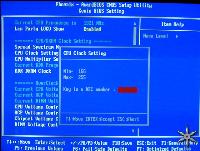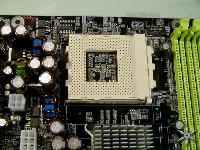After careful consideration I have decided to transfer all hardware review activities to a new domain. I purchased Hardwareasylum.com in 2012 and have been working hard to build a new and improved Ninjalane on that domain. If you are reading this you have reached one of the archived articles, news, projects and/or reviews that were left behind during the site migration.
Please update your bookmarks and be sure to visit the new and improved Ninjalane at Hardwareasylum.com
DFI LanParty KT400A Motherboard Review
Author: Dennis Garcia
Published: Tuesday, June 03, 2003
Overclocking Info
This is the part of the review where I report on my overclocking experiences with the board at hand, normally I would leave this section out but the overclocking process is rather involved.
First things first, I would like to mention that straight up overclocking of the LanParty KT400A was not really that great to begin with. With a stock XP2200+ I could only raise the FSB up to 140Mhz without having windows reboot after reaching the desktop, regardless of Vcore and multiplier settings. I was beginning to think I had a bad board until I decided to go with the trusty ole "wire trick" In the photo below you will notice a thin black line on the CPU socket. This is where you can insert a very thin "U" shaped piece of wire to unlock the lower multipliers on the Tbred processors.
In effect the wire will reset the default multiplier to 5.5 x your current FSB. To finish the overclocking process the system was then powered down and the dipswitch was set to 166Mhz FSB. Using this method you can fool the system into thinking that 166Mhz is the default FSB speed for your processor and at the same time unlock FSB settings from 166 up to 255Mhz.
Knowing that the Soltek SL-75FRV (KT400 chipset) will run at 190Mhz FSB using the wire trick I expected nothing short of that with the LanParty KT400A, I was not disappointed. Though what did surprise me was that at around 180Mhz FSB I started having memory issues while the memory clock set at DDR400.
It seems that the DDR400 clock divider is having some calculation issues at this speed and created a little memory latency, granted this isn't much but still enough to cause stability issues and limited the overclock. For the remainder of the tests the memory clock has been set at DDR333.
The Elusive 200Mhz
Knowing that this processor will run at 200Mhz FSB I tried to do the same with the LanParty KT400A. The system would boot and load windows though after reaching the desktop the video card would crash causing the system to lock up.



